Forest schools are a type of outdoor education in which children (or adults) visit forests/woodlands, learning personal, social and technical skills.
It has been described as “an inspirational process that offers children, young people and adults regular opportunities to achieve and develop confidence through hands-on learning in a woodland environment”.
Forest schools use the woods and forests as a means to establish independence and self-esteem in school-age children. Topics are cross-curriculum (broad in subject) including the natural environment, for example the role of trees in society, the complex ecosystem supported by a wilderness, and recognition of specific plants and animals. However, the personal skills are considered highly valuable, such as teamwork and problem solving. The woodland environment may be utilized to learn about more abstract concepts such as mathematics and communication. Forest schools are also called nature schools.
Activities and Scope
Schedules within forest schools vary, but a typical strategy is to take school children to woodland for once a week, with an initial 6 week observation and assessment period, where a baseline is produced for each child in terms of areas of their holistic development, with particular emphasis on their social and emotional aspects of learning (SEAL). Once the baseline assessment has been produced the Forest Schools Practitioner will then continue with the long term programme over the course of the academic year in order to assist the child in their development and learning. The practitioner will provide chances for each child to develop in areas that have been identified as requiring interventions or support of any kind The duration and frequency of visits influences the degree of outcome; more time spent in forest schools brings greater benefits. Visits should ideally continue throughout the year, enabling children to experience all weathers and the changing seasons.
Forest schools are often “led by the child’s interests” (child initiated learning) by comparison to other outdoor education which “starts with an issue agenda or problem for the children to investigate”. The main goals of forest schools in primary age children covers encouraging curiosity and exploration with all of the senses, empowering children in the natural environment, and encouraging spatial awareness and motor development.
They all learn about flora and fauna but obtain more abstract benefits in social skills such as team-building and cooperation, risk management, project planning and recognition of each student’s own achievements. By setting children small manageable tasks and giving praise, they are given a good foundation for future learning.
Personal skills such as team-building, goal setting, planning and achieving, increasing cooperation to achieve goals, as well as reviewing and recognising own achievements are developed, particularly in secondary school age students. Consistent with Attention Restoration Theory, children taking part in forest schools have been described as more relaxed. Relationships between the children and each other, with adults, and with the environment, are important
Forest schools are part of the broader area of outdoor education. Outside the school curriculum, this extends to summer holiday camps, Scouting, Outward Bound projects and many other activities. Before children reach school age, Forest kindergartens offer a similar service.

